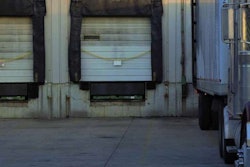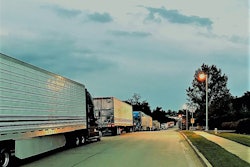
We’re firing up T. Dills Trucking again for a run between the Midwest and the Mid-South and back again. The goal? To illustrate the way the Federal Motor Carrier Safety Administration’s revised hours rule is expected to work come this September.
Sept. 29, to be exact, when drivers will be able to use the split sleeper cycle with the expanded 7/3 option — as it is now, splits can only go up to 8/2. For my money, and you’ll see why in these examples, however, the most significant change here is that the shorter period in the split will “stop” the 14-hour clock; that is, you can exclude that period from calculation of the rolling 14 on-duty clock.
That can deliver a significant flexibility dividend.
The following example, through the third day, hews very closely to my prior how-to on split-sleeper logging, crafted almost two years ago in response to a reader question. For reference, you can pull up that old story at this link.
By the third and fourth days, however, things change in effort to illustrate how the rule allows for the single-day off-duty pause that so many in the audience were looking for as FMCSA mulled over OOIDA and Trucker Nation petitions, and so many of your own suggestions to them.

Apologies to all of you for whom this will all come as second nature. We’ve been getting plenty questions about it since FMCSA’s unveiling of the final rule in May.
OK — T. Dills Trucking’s authority has been reinstated after federal processing, insurance secured for $0 annually in the beautiful climes of imagination-land. Here we go.
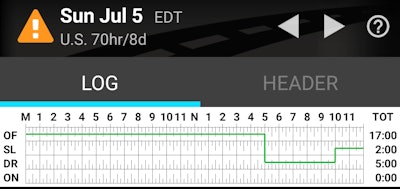 As in my prior scenario, let’s say I started my duty day after a long off period in Ohio (again, no pre-trip — yikes, will probably pay for that later) and drove for five hours starting at 5 p.m. Sunday to Lexington, Kentucky. I’ve got to be loading tomorrow just after 6 a.m., though, so instead of taking 10 down, I can only get in eight in the sleeper, thus starting the split-sleeper cycle. (For split-sleeper to work in the new rules, as in the old, I believe, the longer period must be logged for between 7 and 10 hours sleeper berth, not off-duty. The shorter period can be either off-duty/sleeper or any combination of the two. With one exception, throughout this example I defaulted to the sleeper line when in some cases off-duty might have been more appropriate to the circumstance. I stress: This isn’t the real world!)
As in my prior scenario, let’s say I started my duty day after a long off period in Ohio (again, no pre-trip — yikes, will probably pay for that later) and drove for five hours starting at 5 p.m. Sunday to Lexington, Kentucky. I’ve got to be loading tomorrow just after 6 a.m., though, so instead of taking 10 down, I can only get in eight in the sleeper, thus starting the split-sleeper cycle. (For split-sleeper to work in the new rules, as in the old, I believe, the longer period must be logged for between 7 and 10 hours sleeper berth, not off-duty. The shorter period can be either off-duty/sleeper or any combination of the two. With one exception, throughout this example I defaulted to the sleeper line when in some cases off-duty might have been more appropriate to the circumstance. I stress: This isn’t the real world!) When starting a sleeper split, both under the current rules and the rules going into effect in September, calculation of the 11- and 14-hour limits resets after each break to begin after the previous off-duty period taken. So at 6 a.m. Monday when I go on-duty to do an ultra-fast pre-trip and load (in a grand total of 15 minutes — yeah, this isn’t the real world, folks) I have thus 6 hours of potential driving and 9 hours of potential on-duty time ahead of me. I get to that calculation by going back to 5 p.m. the prior day, the end of my prior off-duty period, counting that drive time and excluding the eight-hour berth period from the duty/drive calculation. Continuing on, I drive the partial load a couple hours to Bardstown, Kentucky, arriving at 8:15 a.m. and staging to fill the load for the next 30 minutes on-duty, at which point they give me a time for when things will be done. I release myself from duty, visit a local distillery for a tour, skip the beverages at the end and return to go back on-duty and drive. My 14 and drive allotments reset when I go back on-duty to begin at 6 a.m. Subtracting 2 hours, 45 minutes on-duty with 2 hours of drive time from the daily 14/11 calculations, I now have a potential 11 hours and 15 minutes of duty time, and 9 hours of potential drive time.
When starting a sleeper split, both under the current rules and the rules going into effect in September, calculation of the 11- and 14-hour limits resets after each break to begin after the previous off-duty period taken. So at 6 a.m. Monday when I go on-duty to do an ultra-fast pre-trip and load (in a grand total of 15 minutes — yeah, this isn’t the real world, folks) I have thus 6 hours of potential driving and 9 hours of potential on-duty time ahead of me. I get to that calculation by going back to 5 p.m. the prior day, the end of my prior off-duty period, counting that drive time and excluding the eight-hour berth period from the duty/drive calculation. Continuing on, I drive the partial load a couple hours to Bardstown, Kentucky, arriving at 8:15 a.m. and staging to fill the load for the next 30 minutes on-duty, at which point they give me a time for when things will be done. I release myself from duty, visit a local distillery for a tour, skip the beverages at the end and return to go back on-duty and drive. My 14 and drive allotments reset when I go back on-duty to begin at 6 a.m. Subtracting 2 hours, 45 minutes on-duty with 2 hours of drive time from the daily 14/11 calculations, I now have a potential 11 hours and 15 minutes of duty time, and 9 hours of potential drive time.This begins to illustrate the benefits of the new rule when it comes to available duty hours. While available drive hours in this example are exactly the same as the prior one, the new rule allows me to exclude the two-hour off-duty period from calculation of the 14-hour clock, giving me a potential two hours more on-duty. Rather than having 9 hours of potential drive time and just 9:15 of duty time, I’ve got 11:15 of potential duty time. Over the course of the next day or two, that rule change is going to be helpful.
I roll for seven hours then to the Birmingham, Ala.-area facility for partial offload in the early a.m., happy I can actually drive seven hours straight without needing to stop for anything (impossible everywhere but in my own imagination and/or for those of you who excel at this sort of thing) and also delighted I can actually park and sleep at this place (not the real world, folks). I get there with time to spare on both drive and 14-hour limits. It’s 6 o’clock and the place is way backed up. They give me a wee-hours time for unload.
Very early to bed, very early to rise. G’night.
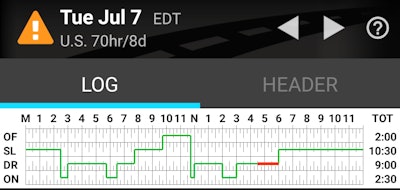 It’s tough to wake at 2 a.m. for most of us, so I manage to get cracking a little after 2:30 in often sunny but now quite dark Birmingham, where overnight dock hands are hard at work as I rub the sleep out of my eyes to watch them make quick work of some skids. (Great parking and bathroom facilities at this receiver, too — oh, the wonders of the imagination!) When I come back on-duty for all of this at about 2:30 a.m., I recalculate available drive and duty hours. As in the old rules, the eight-hour berth period doesn’t count toward the 14, so I have 4 hours of available drive time and just under 7 hours of available on-duty time. Good thing. I’ve got a couple-hour haul back up 65 in the direction of Nashville to offload the rest of this at 6 a.m., then about an hour of southerly movement back into Alabama to position for the next load. I get it all done in about 5 hours of duty time, then crash out for a couple hours in the sleeper.
It’s tough to wake at 2 a.m. for most of us, so I manage to get cracking a little after 2:30 in often sunny but now quite dark Birmingham, where overnight dock hands are hard at work as I rub the sleep out of my eyes to watch them make quick work of some skids. (Great parking and bathroom facilities at this receiver, too — oh, the wonders of the imagination!) When I come back on-duty for all of this at about 2:30 a.m., I recalculate available drive and duty hours. As in the old rules, the eight-hour berth period doesn’t count toward the 14, so I have 4 hours of available drive time and just under 7 hours of available on-duty time. Good thing. I’ve got a couple-hour haul back up 65 in the direction of Nashville to offload the rest of this at 6 a.m., then about an hour of southerly movement back into Alabama to position for the next load. I get it all done in about 5 hours of duty time, then crash out for a couple hours in the sleeper.When I wake up, I know I’m close to where old friend and colleague (and a gentleman whose name you’ll recognize) Mr. James Jaillet lives in Huntsville. I give him a call and he shows up at the truck with takeout burgers (let’s say we eat eight feet apart by the trailer yelling at each other between mouthfuls over the hum of the truck next-door, then don masks for a chat about what he’s been up to slightly closer together).
Turns out (and I know this already — that’s why I’m here!), he’s been moonlighting in bicycle salvage and reconditioning in his spare time, and he’s got a small load he wants me to run to a facility in Nashville, with another straight back on the return. I’ve got time, I tell him, thanks to the new hours rule. (Yeah, he’s heard about that one, he says…)
When I come back on-duty at 11:45 a.m., still in the split sleeper cycle, you know the drill: Recalculate available hours. Under the terms of the new rule, I can exclude the combined sleeper berth/off-duty period of 4 hours from my calculation of the 14: Under the old rule, I’d have just 4 hours and 45 minutes on the 14, and the same amount of drive time available, but with the new rule, I’ve got a potential 8:45 of duty time, and 7 hours of drive time total. Plenty to get it done barring any major snafus. Load/unload in Nashville takes an hour, though I hit a rush-hour slowdown coming back into Huntsville and miss the load appointment.
That’s OK, though, the ever-dependable and nonjudgmental Mr. Jaillet shows up and hand-unloads the rig while I sleep off a long day, for a long, long time. (Note the bold red line on the grid above — that’s the BigRoad logbook app telling me this log is not doable under the current rules, given that’s where the rolling 14-hour clock in the split cycle would have otherwise run out as duty time eroded under those rules — not so come Sept. 29, 2020.)
Achieving a one-time 14-hour-clock pause with the new split-sleeper rules
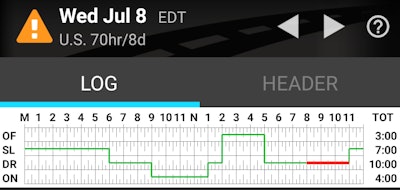 On the way back to the Huntsville area yesterday I booked a load bound for Northern Illinois for today that picks up near Nashville. I’ve got some friends up I-24 from there in Clarksville I haven’t seen in ages, so I began planning this day around an extended stop there. Under the terms of the new rule, I’ll be able to utilize an extended three-hour stop off-duty as part of a new split cycle to see them for lunch, I figure. After spending the better part of 12 hours off-duty, I’m out of the split-sleeper cycle now and when I hit the road empty at 6 a.m. (neglecting to log my pre-trip again, yikes will probably pay for that later) I have a full daily complement of 14 on-duty and 11 drive hours. Loading at a facility Northwest of Nashville off I-24, though, things go awry and I sit in queue with a dozen or more other rigs and wait, and wait, and wait. I kvetch with the broker, talk to some of my fellow haulers about what could be the hold-up at what a regular tells me is typically a pretty fast facility, and four hours elapses before the load’s on. I alert my Clarksville pals to the necessity of a late lunch, today. We finish up in two hours, then I lean my head back in the seat for the last hour for a little shut-eye to rest up for a long run. That puts the break at three hours.
On the way back to the Huntsville area yesterday I booked a load bound for Northern Illinois for today that picks up near Nashville. I’ve got some friends up I-24 from there in Clarksville I haven’t seen in ages, so I began planning this day around an extended stop there. Under the terms of the new rule, I’ll be able to utilize an extended three-hour stop off-duty as part of a new split cycle to see them for lunch, I figure. After spending the better part of 12 hours off-duty, I’m out of the split-sleeper cycle now and when I hit the road empty at 6 a.m. (neglecting to log my pre-trip again, yikes will probably pay for that later) I have a full daily complement of 14 on-duty and 11 drive hours. Loading at a facility Northwest of Nashville off I-24, though, things go awry and I sit in queue with a dozen or more other rigs and wait, and wait, and wait. I kvetch with the broker, talk to some of my fellow haulers about what could be the hold-up at what a regular tells me is typically a pretty fast facility, and four hours elapses before the load’s on. I alert my Clarksville pals to the necessity of a late lunch, today. We finish up in two hours, then I lean my head back in the seat for the last hour for a little shut-eye to rest up for a long run. That puts the break at three hours.According to the new hours rules, such an off-duty break must at least be two hours long to enter the split sleeper cycle and stop the 14-hour clock. My break is three, so I’m now in split sleeper, the clock stops ticking away my available time, and, back on-duty at 5, I still have both 7 on-duty and drive hours available, despite the shipper’s long delay earlier, plenty of time to get to where I’m going — to stage to unload tomorrow with an early afternoon appointment time. (Again, the bold red line near the latter part of the day in the grid above is showing where the time would run out under the rules we have today, which don’t allow you to stop the 14 with a short break/nap like this. Come Sept. 29, it will be possible.)
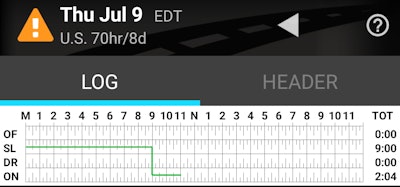 I take a full ten off-duty this time around, releasing myself from the split-sleeper cycle. When I come on-duty to write this story at 9 a.m. I’ve got my full complement again of 14 duty and 11 drive hours. There’s no need to exactly match off-duty periods in the split cycle, ultimately, which means that you can use a two-hour or longer off-duty break like a pause button, as illustrated in the prior grid — if you follow that with 10 off, your daily limits just reset, releasing you from the rolling calculations of the split cycle.
I take a full ten off-duty this time around, releasing myself from the split-sleeper cycle. When I come on-duty to write this story at 9 a.m. I’ve got my full complement again of 14 duty and 11 drive hours. There’s no need to exactly match off-duty periods in the split cycle, ultimately, which means that you can use a two-hour or longer off-duty break like a pause button, as illustrated in the prior grid — if you follow that with 10 off, your daily limits just reset, releasing you from the rolling calculations of the split cycle.For those who remained mystified by the new up-to-7/3 split, I hope this helps. And if you’re not so mystified: feel free to offer corrections and clarifications if I’ve missed anything.
If anything’s unclear, hit me with a message or a call with a question — leave them on our Overdrive Radio podcast line at 530-408-6423 and maybe I might just try to answer them in a future audio edition.
Stay safe, stay well.

